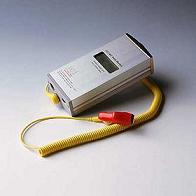Antistatic, static electricity, dust and particle problems
Main menu:
Measuring Techniques & Instruments for evulation of static electricity
Products
Measuring Techniques & Instruments
One has to distinguish between electrostatic charges on material surfaces, objects or particles of a material and electrostatic properties such as surface and volyme resistance, decay time, relative capacitance and rechargeability.
We can measure the electrostatic field strength kV/m with our instruments (field mill) from JCI (Child Worth) and Monroe Electronics. These measurements are mainly non-contact with the electrostatic field meter, but also electrostatic voltmeters with appropriate probes are available.
Measurements can be made at the customer or in Swedish Electrostatic AB and may be a simple measurement of a production machine using a handheld field mill or made after careful conditioning of both sample and measuring instrument in well-documented conditions (ambient temperature and humidity).
In running production the field strength can be monitored with a data collection equipment for later analysis or to alarm at a given level.
Read more about Services-> Measuring Services and our test equipment for training and evaluation of antistatic and charging
- Surface and volyme resistance is measured in accordance with current standards. A couple of different instruments are available and equipped with standardized probes according to what is described in the relevant standard.
- Decay time is measured with a decay time meter JCI155. This measurement provides a direct image of a process so that it looks like in an actual production situation. A material sample is charged under controlled conditions and the decay time and the current decay time curve is recorded, while one can measure the amount of charge-received, relative capacitance and peak charging value of the sample. Read more about examples of decay time.
- Net charge of a sample can be measured using Faraday's cup (cup) or Faraday's box. The sample may be solid or liquid. The cup or box is designed to fit the current sample which may be liquid if one milliliter or one item of clothing such as a suit or other large objects.
Measuring Instruments
Work with static electricity requires special measuring devices if you want to conduct a reasonably systematic work. The instruments normally used by an electrician is not good enough because the reading metrics when working with static electricity is so extreme.
Hence, an ordinary multimeter is not suitable for measuring purposes, when the voltage is too high, the current is too low, and the resistance is too high. When talking about the measurement of static electricity in general, it refers to an electrostatic field strength which is measured without contact in kV / m and require field meter.
We have both a simpler instrument to work mainly with solving problems in production environments, and more skilled field mills for more accurate measurements and measurements in difficult environments. An excellent way to quantify a material's antistatic properties is to measure its decay time with a decay time instrument, which gives a direct image how the material is charged and discharged by a process. To control the measurement of potential of ionization devices and generators a high-voltage measurement probe is needed, which can be connected to a suitable multimeter. Among the more specialized instruments include the electrostatic voltmeter or high-voltage measurement probe with extremely high input impedance for the measurement of very small amounts of charge as field meters.
